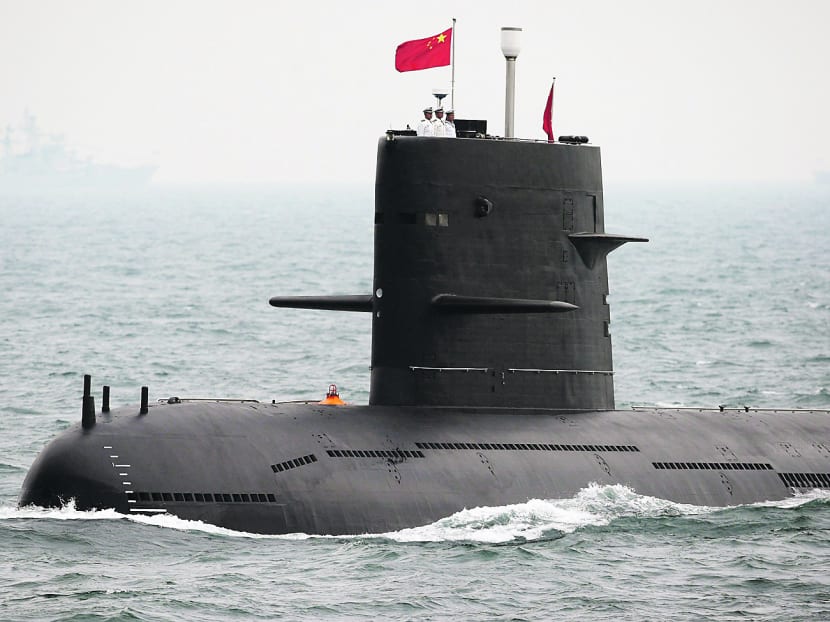China’s supersonic ship killer makes US navy’s job harder
HONG KONG — Increased interactions between the the Chinese and US navy in the contested South China Sea risk becoming more complicated by the increasingly sophisticated missiles being carried by submarines.

A Chinese navy submarine. Reuters file photo
HONG KONG — Increased interactions between the the Chinese and US navy in the contested South China Sea risk becoming more complicated by the increasingly sophisticated missiles being carried by submarines.
A new report to the US Congress assessing a Chinese submarine-launched missile known as the YJ-18 highlights the danger, noting the missile accelerates to supersonic speed just before hitting its target, making it harder for a crew to defend their ship.
Defence chiefs from several countries in South-east Asia have warned in recent months of the danger of undersea “clutter” as countries build up submarine fleets and the US challenges China over its claim to a large swath of the South China Sea. This week’s US patrol inside the 12-nautical mile zone that China claims around its man-made islands in the waters saw the USS Lassen shadowed by two Chinese naval vessels.
The YJ-18 missile can cruise at about 965.6km an hour, or just under the speed of sound, only a few metres above the surface of the sea and then, about 20 nautical miles from its target, accelerate to as much as three times the speed of sound, according to an Oct 28 report from the US-China Economic and Security Review Commission.
“The supersonic speed makes it harder to hit with on-board guns,” according to commission Chairman Larry Wortzel. “It also makes it a faster target for radars.”
‘SERIOUS IMPLICATIONS’
The YJ-18’s speed and long range, as well as its wide deployment “could have serious implications for the ability of US Navy surface ships to operate freely in the Western Pacific” in the event of a conflict, the commission found.
Its report came just days after the US warship entered the 12-mile zone around the reefs that China’s turned into man-made islands, one of which may soon be equipped with an airstrip capable of handling the military’s largest aircraft. By passing so close, the US was showing it doesn’t recognise that the feature qualifies for a territorial zone under international law.
Provocative actions by the US may bring serious tensions between the two militaries and may even result in skirmishes, China’s navy commander Wu Shengli told US Chief of Naval Operations John Richardson on a conference call yesterday (Oct 29), according to the Chinese navy’s microblog.
SHIPPING LANE
The waters are a vital thoroughfare for the global economy, hosting US$5 trillion (S$7 trillion) of international shipping a year. China claims more than 80 per cent of the sea, vying with five rival claimants, including Vietnam and Philippines.
The Office of Naval Intelligence said in its April report on the People’s Liberation Army Navy that China had started to deploy its newest missile, but didn’t give precise details on its range. The Commission said the YJ-18 can travel about 290 nautical miles, more than 14 times as much as its predecessor, the YJ-82. It cited media reports and other unclassified sources.
YJ-18 THREAT RING (RED) Vs YJ-82 THREAT RING (YELLOW)
“One goal of the Chinese counter-intervention strategy, which we call anti-access/area denial, is to keep opposing forces away from China’s coast and from the waters inside the First Island Chain,” said Dr Wortzel. The missiles would be “particularly helpful in implementing the naval strategy of keeping an opponent outside the range of Tomahawk cruise missiles and carrier-based fighters and away from the Chinese coast”.
The First Island Chain is the name given by Chinese analysts for the series of archipelagos that stretch from Russia down past Japan and Taiwan and toward the coasts of the Philippines, Brunei and Malaysia.
GOOD NEWS
The report does however contain some potentially good news for US naval commanders.
China’s command and control infrastructure may be insufficient to generate the targeting information needed to take advantage of the YJ-18’s range. Also, the command and control system itself may be vulnerable to countermeasures such as electromagnetic warfare operations, making it difficult for the PLA to track ships and employ the missiles.
The YJ-18 should not be confused with the so-called “carrier killer” DF-21 anti-ship ballistic missile, which was paraded during China’s commemorations to mark the 70th anniversary of Japan’s defeat in World War II. The DF-21, which would target aircraft carriers, would be fired from land-based mobile launchers. The YJ-18 could impede the progress of a carrier group, the commission report said.
The commission was created by the US Congress in 2000 to investigate and submit an annual report on the national security implications of trade with China. BLOOMBERG





